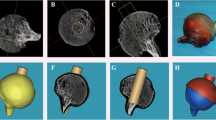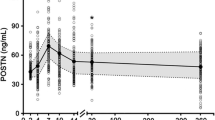Abstract
Based on the present definition of osteoporosis, both bone density and quality are important factors in the determination of bone strength. Collagen crosslinking is a determinant of bone quality. Cross-links can form enzymatically by the action of lysyl oxidase or non-enzymatically, resulting in advanced glycation end products. Collagen crosslinking is affected by tissue maturation as well as the degree of mineralization. Homocysteine and vitamin B6 (pyridoxal) are also regulatory factors of collagen crosslinking. We elucidate the relationship between the degree of mineralization and collagen cross-links in cancellous bone from hip fracture cases. We also determined plasma levels of homocysteine and pyridoxal. Twenty-five female intracapsular hip fracture cases (78 ± 6 years) and 25 age-matched postmortem controls (77 ± 6 years) were included in this study. Collagen crosslinking was analyzed after each bone specimen was fractionated into low (1.7–2.0 g/ml) and high (>2.0 g/ml) density fractions. The content of enzymatic (immature reducible and mature nonreducible cross-links) and nonenzymatic cross-link (pentosidine) were determined. In the controls, there was no difference in total enzymatic cross-links between low and high density bone, while pentosidine content was significantly higher in high density bone. In the fracture cases, not only reduced enzymatic cross-links in high density bone and increased pentosidine in both low and high density bone, but also higher plasma homocysteine and lower pyridoxal levels were evident compared with the controls. These results indicate that detrimental crosslinking in both low and high mineralized bone result in impaired bone quality in osteoporotic patients.



Similar content being viewed by others
References
Burr BB (2002) Bone material properties and mineral matrix contributions to fracture risk or age in women and men. J Musculoskelet Neuronal Interact 2:201–204
Gearnero P, Delmas PD (2004) Contribution of bone mineral density and bone turnover markers to the estimation of risk of Osteoporotic fracture in postmenopausal wemen. J Musculoskelet Neuronal Interact 4:50–63
Paschalis EP, Shne E, Lyritis D, Skaeantavos G, Mandelsohn R, Boskey AL (2004) Bone fragility and collagen cross-links. J Bone Miner Res 19:2000–2004
Boivin GY, Meunier PJ (2003) The mineralization of bone tissue: a forgotten dimension in osteoporosis research. Osteopor Int 14 supple 3:S19–S24
Mashiba T, Mori S, Burr DB, Komatsubara S, Cao Y, Manabe T, Norimatsu H (2005) The effects of suppressed bone remodeling by bisphosphonates on microdamage accumulation and degree of mineralization in the cortical bone of dog rib. J Bone Miner Metab 23 Supple:36–42
Mori S,Harruff R, Ammrosius W, Burr DB (1997) Trabecular bone volume and microdamage accumulation on the femoral heads of women with and without femoral neck fractures. Bone 21:521–526
Wang X, Shen X, Li X, Agrawal CM (2002) Age-related changes in the collagen network and toughness of bone. Bone 31:1–7
Banse X, Sims TJ, Bailey AJ (2002) Mechanical properties of adult vertebral cancellous bone: correlation with collagen intermolecular cross-links. J Bone Miner Res 17:1621–1628
Oxlund H, Barckman M, Ortoft G, Andreassen TT (1995) Reduced concentrations of collagen cross-links are associated with reduced strength of bone. Bone 17:365S–371S
Oxlund H, Mosekilde L, Ortoft G (1996) Reduced concentration of collagen reducible crosslinks in human trabecular bone with respect to age and osteoporosis. Bone 19:479–484
Zioupos P, Currey JD, Hamer AJ (1999) The role of collagen in the declining mechanical properties of aging human cortical bone. J Biomed Mater Res 45:108–116
Kuboki Y, Kudo A, Mizuno M, Kawamura M (1992) Time-dependent changes of collagen cross-links and their precursors in the culture of osteogenic cells. Calcif Tissue Int 50:473–480
Saito M, Fujii K, Tanaka T, Soshi S (2004) Effect of low- and high-intensity pulsed ultrasound on collagen post-translational modifications in MC3T3-E1 osteoblasts Calcif Tissue Int 75:384–385
Saito M, Soshi S, Tanaka T, Fujii K (2004) Intensity-related differences in collagen post-traslational modification in MC3T3-E1 osteoblasts after exposure to low and high intensity pulsed ultrasound. Bone 35:644–655
Saito M, Soshi S, Fujii K (2003) Effect of hyper- and microgravity on collagen post-translatonal controls of MC3T3-E1 osteoblasts. J Bone Miner Res 18:1695–1705
Uzawa K, Grzesik WJ, Nishiura T, Kuznetsov SA, Robey PG, Brenner DA, Yamauchi M (1999) Differential expression of human lysyl hydroxylase genes, lysyl hydroxylation, and cross-linking of type I collagen during osteoblastic differentiation in vitro. J Bone Miner Res 14:1272–1280
Yamauchi M, Katz EP (1993) The post-translational chemistry and molecular packing of mineralizing tendon collagens. Connect Tissue Res 29:81–98
Eyre DR, Dickson IR, Ness KV (1988) Collagen cross-linking in human bone and articular cartilage. Age-related changes in the content of mature hydroxypyridinium residues. Biochem J 252:495–500
Marumo K, Saito M, Yamagishi M, Fujii K (2005) The “ligamentization” process in human anterior cruciate ligament reconstruction with autogenous patellar and hamstring tendons. Am J Sports Med 33:1166–1173
Saito M, Marumo K, Fujii K, Ishioka N (1997), Single column high – performance liquid chromatographic - fluorescence detection of immature, mature and senescent cross-links of collagen. Anal Biochem 253:26–32
Vashishth D, Gibson GJ, Khoury JI, Schaffler MB, Kimura J, Fyhrie DP (2001) Influence of nonenzymatic glycation on biomechanical properties of cortical bone. Bone 28:195–201
McCarthy AD, Etcheverry SB, Bruzzone L, Lettieri G, Barrio DA, Cortizo AM (2001) Non-enzymatic glycation of a type I collagen matrix: effect on osteoblastic development and oxidative stress. BMC Cell Biol 2:16
Paul RG, Bailey AJ (1996) Glycation of collagen: the basis of its central role in the late complications of ageing and diabetes. Int. J Biochem Cell Biol 28:1297–1310
Sell DR, Monnier VM (1989) Structure elucidation of a senescence cross-link from human extracellular matrix, Implication of pentoses in the aging process. J Biol Chem 264:21597–21602
McLean RR, Jacques PF, Selhub J, Tucker KL, Samelson EJ, Broe KE, Hannan MT, Cupples LA, Kiel DP (2004) Homocysteine as a predictive factor for hip fracture in older persons. N Engl J Med 350:2042–2049
van Meurs JB, Dhonukshe-Rutten RA, Pluijm SM, van der Klift M, de Jonge R, Lindemans J, de Groot LC, Hofman A, Witteman JC, van Leeuwen JP, Breteler MM, Lips P, Pols HA, Uitterlinden AG (2004) Uitterlinden, Homocysteine levels and the risk of osteoporotic fracture. N Engl J Med 35:2033–2041
Reynolds TM, Marshall PD, Brain AM (1992) Hip fracture patients may be vitamin B6 deficient. Controlled study of serum pyridoxal 5 phosphate. Acta Orthop Scand 63:635–638
Khan M, Yamauchi M, Srisawasdi S, Stiner D, Doty S, Paschalis EP, Boskey AL (2001) Homocysteine decrease chondrocyte-mediated matrix mineralization in differentiating limb-bud mesenchymal cell micro-mass cultures. Bone 28:387–398
Lubec B, Fang-Kircher S, Lubec T, Blom HJ, Boers GHJ (1996) Evidence for McKusick’s hypothesis of deficient collagen cross-linking in patients with homocystinuria. Biochim Biophys Acta 13:159–162
Bird TA, Levene CI (1982) Lysyl oxidase: evidence that pyridoxal phosphate is a co-factor. Biochem Biophys Res Commun 108:1172–1180
Grynpas MD (1993) Age and disease-related changes in the mineral of bone. Calcif Tissue Int 53 supple1:S57–S64
Turner CH (2002) Biomechanics of bone: determinants of skeletal fragility and bone quality. Osteoporos Int 13 (2002) 97–104
Jowsey J (1964) Variation in bone mineralization with age and disease. In: Bone Biodynamics, Little Brown, Boston, pp. 461–479
Meunier PJ, Boivin G (1997) Bone mineral density reflects bone mass but also the degree of mineralization of bone: Therapeutic implications. Bone 21:373–377
Muthusami S, Ramachandran I, Muthusamy B, Vasudevan G, Prabhu V, Subramaniam V, Jagadeesan A, Narasimhan S (2005) Ovariectomy induces oxidative stress and impairs bone antioxidant system in adult rats. Clin Chim Acta 360:81–86
Russell JE, Avioli LA (1972) Effect of experimental chronic renal insufficiency on bone mineral and collagen maturation. J Clin Invest 51:3072–3079
Grynpas MD, Hunter GK (1988) Bone mineral and glycosaminoglycans in newborn and mature rabbits. J Bone Miner Res 3:159–164
Saito M (1999) Age-related changes in biochemical characteristics of collagen from human weight-bearing and non-weight-bearing bone. Tokyo Jikeikai Medical Journal 114:327–337 (in Japanese)
Grynpas MD, Marie PJ (1990) Effects of low doses of strontium on bone quality and quantity in rats. Bone 11:313–319
Sodek KL, Tupy LH, Sodek J, Grynpas MD (2000) Relationship between bone protein and mineral developing porcine long bone and calvaria. Bone 26:189–198
Termine JD, Eanes ED, Greenfield DJ, Nylen MU (1973) Hydrazine deproteinated bone mineral. Calcif Tissue Res 12:73–90
Vukicevic S, Stavljenic A, Boll T, Vujicic G, Degenhardt C, Cervar M, Krempien B (1989) Effects of parathyroidectomy on tissue calcium, phosphorus, magnesium, and copper concentrations in aluminum-loaded uremic rats. Biol Trace Elem Res 22:45–53
Eyre DR, Koob TJ, Van Ness KP (1984) Quantification of hydroxypyridinium crosslinks in collagen by High-Performance Liquid Chromatography. Anal Biochem 137:380–388
Araki A, Sako Y (1987) Detremination of free and total homocysteine in human plasma by high-performance liquid chromatography with fluorescence detection. J Chromatogr 422:43–52
Tani Y (1983) Assay methods of vitamin B6 1. Separation and determination of vitamin B6. Vitamins 57:263–271 (in Japanese)
Yoshida T, Yunoki N, Nakajima Y, Kaito T, Anmo T (1978) Simultaneous determination of vitamin B6 group in blood by high-performance liquid chromatography (HPLC). Yakuzai Zassi 98:1319–1326 (in Japanese)
Paschalis EP, ,Recker R, Dicarlo E, Doty SB, Atti E, Boskey AL (2003) Distribution of collagen cross-links in normal human trabecular bone. J Bone Miner Res 18:1942–1946
Fujii K, Kajiwara T, Kurosu H (1979) Effect of vitamin B6 deficiency on the crosslink formation of collagen. FEBS Lett 97:193–195
Masse PG, Rimnac CM, Yamauchi M, Coburn SP, Rucker RB, Howell DS, Boskey AL (1996) Pyridoxine deficiency affects biomechanical properties of chick tibial bone. Bone 18:567–574
Grynpas M (1993) Age and disease-related changes in the mineral of bone. Calcif Tissue Int 53(supple 1):S57–S64
Mbyu-Muamba JM, Dequeker J, Gevers G (1989) Collagen and non-collagenous proteins in different mineralization stages of human femur. Acta Anat 134:265–268
Simmons DJ, Russel JE, Geynpas MD (1986) Bone maturation and quality of bone material in rats flown on the space shuttle Spacelab-3Mission. Bone and Mineral 1:485–493
Boskey AL, Marks SC (1985) Mineral and matrix alterations in the bones of incisors-absent (ia/ia) osteopetrotic rats. Calcif Tissue Int 37:287–292
Paschalis EP, V Paschalis EP, Verdelis K, Doty SB, Boskey AL, Mendelsohn R, Yamauchi M (2001) Spectroscopic characterization of collagen cross-links in bone. J Bone Miner Res 16:1821– 1828
Yamauchi M, Katz EP (1993) The post-translational chemistry and molecular packing of mineralizing tendon collagens. Connect Tissue Res 29:81–98
Katayama Y, Akatsu T, Yamamoto M, Kugai N, Nagata N (1996) Role of nonenzymatic glycosylation of type I collagen in diabetic osteopenia. J Bone Miner Res 11:931–937
Fujii K, Kuboki Y, Sasaki S (1976) Aging of human bone and cartilage collagen: changes in the reducible cross-links and their precursors. Gerontology 22:363–370
Baynes JW (1991) Role of oxidative stress in development of complications in diabetes. Diabetes 40:405–412
Starkebaum G, Harlan JM (1986) Endothelial cell injury due to copper-catalyzed hydrogen peroxide generation from homocysteine. J Clin Invest 77:1370–1376
Eberhardt RT, Forgione MA, Cap A, Leopold JA, Rudd MA, Trolliet M, Heydrick S, Stark R, Klings ES, Moldovan NI, Yaghoubi M, Goldschmidt-Clermont PJ, Farber HW, Cohen R, Loscalzo J (2000) Endothelial dysfunction in a murine model of mild hyper homocyst(e)inemia. J Clin Invest 106:483–491
Bailey AJ, Wotton SF, Simes TJ, Thompson PW (1992) Post-translational modification in the collagen human osteoporotic femoral head. Biochem Biophys Res Commun 185:801–805
Robins SP (1982) Analysis of the crosslinking components in the collagen and elastin. Methods Biochem Anal 28:329–379
Reiser KM (1991) Nonenzymatic glycation of collagen in aging and diabetes. Proc Soc Exp Biol Med 196:17–29
Acknowledgments
The authors are grateful to Takaaki Tanaka Ph.D (NHO, National Utsunomiya Hospital, Tochigi, Japan), Ryuichi Fujisawa Ph.D (Hokkaido University, Japan) and Kazumi Hirakawa (Jikei University School of Medicine) for technical support.
Author information
Authors and Affiliations
Corresponding author
Additional information
All authors have no Conflict of interest policy.
Rights and permissions
About this article
Cite this article
Saito, M., Fujii, K. & Marumo, K. Degree of Mineralization-related Collagen Crosslinking in the Femoral Neck Cancellous Bone in Cases of Hip Fracture and Controls. Calcif Tissue Int 79, 160–168 (2006). https://doi.org/10.1007/s00223-006-0035-1
Received:
Accepted:
Published:
Issue Date:
DOI: https://doi.org/10.1007/s00223-006-0035-1




